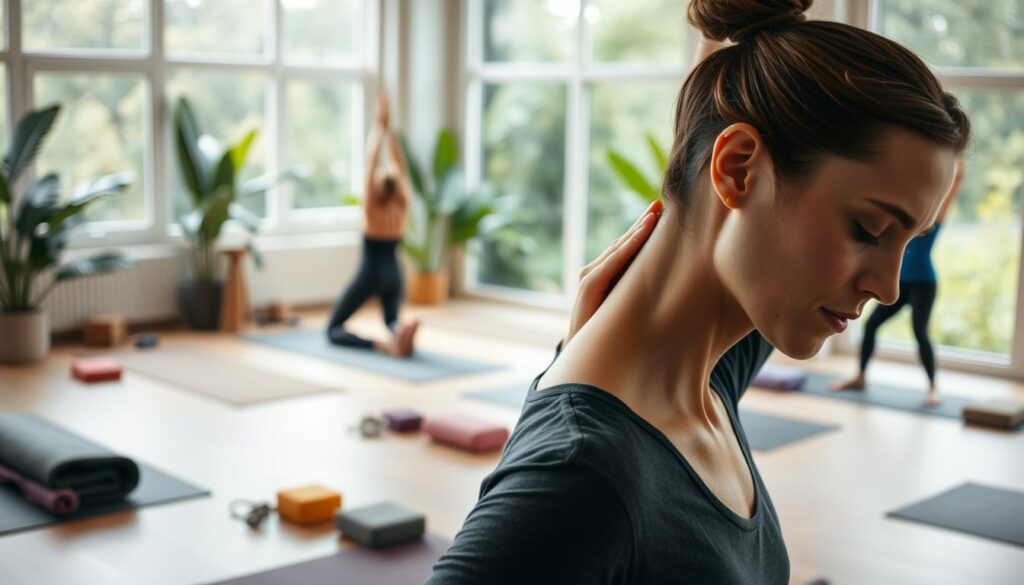In our fast-moving world, finding good ways to handle neck pain is very important. About 20% of adults feel neck pain within a year, and it often comes back. This shows the need for lasting solutions to neck pain.
Regular physical exercise is a fantastic way to fight chronic neck pain. By adding specific exercises to daily life, people can reduce pain a lot. This improves their overall quality of life.
The Importance of Addressing Neck Pain
Neck pain is a major health issue for many people. Treating neck pain is crucial because it affects everyday life and happiness. Recognizing the need for quick action helps stop pain from getting worse and becoming chronic. This can lead to feeling really down and having trouble moving.
Neck pain also has big effects on money matters. It makes people use more healthcare, which costs a lot for both them and the system. People often need lots of treatments for ongoing pain. Because of this, it’s smart to deal with neck pain early instead of letting it get bad.
Furthermore, chronic neck pain can really bring down your mental health. Stress and worry are common when you’re in pain all the time. But getting the right treatment and doing certain exercises can make a big difference. This not only helps you feel better physically but also mentally. Taking care of neck pain soon is key to improving your quality of life.
Understanding Neck Pain: Prevalence and Causes
Every year, 30 to 50% of adults deal with neck pain. The issue is especially common among office workers. They sit too long and often don’t have a good setup. Knowing the causes of cervicalgia is key for better handling it.
Common reasons for neck pain include:
- Poor posture during daily activities
- Muscle tension from stress or repetitive strain
- Degenerative conditions like osteoarthritis
- Injuries from accidents or falls
- Herniated discs impacting nerve roots
To avoid neck pain, it’s important to recognize its triggers. Factors like age, not moving enough, and certain exercises can raise the risk. Knowing this helps create plans to prevent pain, focusing on what each person needs.
Types of Exercise Beneficial for Neck Pain Relief
Finding the right exercises for neck pain relief is important. Different kinds can help a lot, like motor control exercises, Pilates, resistance training, traditional Chinese exercises, and yoga. Each one helps improve neck stability and flexibility in its own way.
Motor control exercises work on making the muscles around the neck work together better. This helps support the neck and reduce pain. Pilates makes your core stronger and helps keep your spine aligned. This is really important for your spine’s health. Traditional Chinese exercises, like Tai Chi, are about gentle movements and stretching. They can ease stiffness and make moving your neck easier.
Resistance training isn’t talked about much but it’s great for making your neck and upper back stronger. This helps a lot with everyday tasks. Doing these exercises regularly can make your neck stronger and less painful. Yoga is about calming your mind and body, which helps a lot if your neck pain is chronic.
Although these exercises seem helpful at first, more studies are needed. Knowing the best mix of exercises can improve life for those with neck pain.
The Role of Motor Control Exercises in Neck Pain Management
Motor control exercises are key for handling neck pain by strengthening the deep neck muscles. They make the neck more stable and fix muscle problems causing pain. These exercises also improve coordination through better proprioception, crucial for neck rehab.
Doing motor control exercises regularly helps reduce neck pain and prevents future injuries. The main benefits are:
- Enhanced strength of deep cervical muscles.
- Improved stability and support of the cervical spine.
- Reduction in pain and discomfort associated with neck issues.
Adding these exercises to a rehab plan boosts neck function. This means everyday activities become easier and less painful.
How Exercise Impacts Neck Pain Long-Term
It’s important to know how exercise helps with neck pain over time. Studies show that exercise is key for managing and fixing neck pain. For example, reviewing lots of studies helps us understand that different exercises can really help with neck pain and other problems.
Evidence from Systematic Reviews on Exercise Types
Research from 25 reviews tells us that various exercises can quickly help those with neck pain. Specifically, exercises focusing on precise muscle control seem very promising. However, not all exercises work the same for everyone, leading to mixed results in their long-term benefits.
Comparison of Exercise Interventions and Their Efficacy
Although many exercises help reduce neck pain, not one type is best for everyone. Except for resistance training, all exercises seem helpful. This shows we need more detailed studies to better understand which exercises are most effective for neck pain, providing clear advice for both doctors and patients.
Yoga and Its Long-Term Benefits for Neck Pain
Yoga has become a popular way to tackle neck pain, mixing physical poses with breath control. It boosts flexibility and helps calm the mind, aiding in stress relief. Lots of people say regular yoga makes their neck feel better over time.
Yoga poses gently stretch and fortify neck muscles, easing tension and soreness. The breathing techniques in yoga also bring deep relaxation. It’s a whole-body approach to soothing neck pain.
Studies show regular yoga leads to lasting benefits. Moving, breathing, and staying mindful work together for a healthier neck. Folks usually enjoy less pain and feel better overall, highlighting yoga as a great choice for neck pain relief.

Resistance Training as a Solution for Chronic Neck Pain
Resistance training is a great way to deal with chronic neck pain. It makes the neck and shoulder muscles stronger, leading to less pain. By using weights or bands, it supports muscle growth and keeps the neck stable.
The benefits of this training might not show right away but keep at it. Over time, it can really help reduce neck pain and improve your ability to do everyday activities. Studies show that sticking with it can boost your physical abilities and ease pain.
- Improves muscle strength and endurance.
- Enhances posture and alignment.
- Reduces reliance on pain medication.
- Promotes long-term chronic pain solutions through physical resilience.
Making resistance training part of your routine can be a key action for those with chronic neck pain. Learning how it works can help people start their path to feeling better. It’s a step towards taking control of your health and recovery.
Complementary Approaches to Exercise for Neck Pain Relief
Adding other treatments can boost traditional exercise plans for those with neck pain. Techniques like massage therapy, acupuncture, and physical therapy help in a full care plan for neck pain. These treatments aim to ease pain and also improve overall health.
Massage therapy eases muscle stiffness, boosts blood flow, and relaxes the body. When paired with neck pain relief exercises, people often feel more flexible and less in pain. Acupuncture, by pinpointing certain spots, helps balance the body and aids its healing abilities.
Physical therapy makes exercise plans work better by creating customized plans, teaching the right way to do exercises, and informing people about their health issues. Using both exercise and these added treatments offers a better way to manage and heal neck pain.
The Psychological Aspect of Chronic Neck Pain and Exercise
Chronic neck pain often comes with feelings like anxiety, depression, and stress. These feelings can make the pain worse. This creates a cycle that lowers your quality of life. It’s crucial to tackle these emotional effects to manage the pain well.
Exercise is a key way to deal with these issues. It boosts your mood by releasing endorphins. This lowers anxiety and depression. Improved mood helps fight off chronic pain better.
Seeing exercise in a positive light helps stick to a routine. People who find exercise useful tend to do better physically and mentally. Setting achievable fitness goals keeps you going. It brings lasting benefits for both your body and mind.
Conclusion
Exercise is key for dealing with chronic neck pain in a whole-body way. Activities like yoga, weight lifting, and specific motion exercises are crucial. They must be chosen based on what each person needs. This approach helps improve both body strength and mental health, making life better.
Staying active is important for managing neck pain over time. It lets people take control of their well-being. This leads to less pain and better movement. As research grows, it’s key to keep making these exercise plans better and more tailored to each person.
Adding these exercises to your daily life can reduce neck pain now and prevent it later. The strong evidence shows that exercise greatly eases chronic neck pain. It’s a vital part of staying healthy overall.



